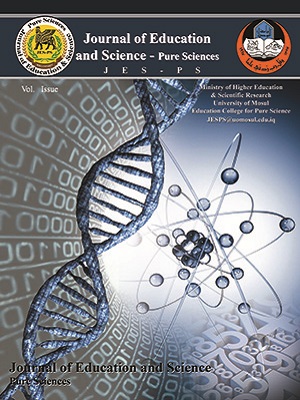Abstract
The present study aimed to discover the histopathological of the Monosodium glutamate (MSG),
and Sodium nitrite (NaNO2), on the embryonic development of the eyes of albino mice Mus
musculus. On the fourteenth and eighteenth day of pregnancy, the stage of organogenesis in these
animals. A concentration of 9 g/kg of MSG, a concentration of 110 mg/kg of NaNO2, and the interaction
between them used. The results of the study showed the presence of pathological changes to the eyes of
the fetuses. The eye on the 14th day of pregnancy, when 9 g/kg of MSG used, there were retinal
duplication, increased vascularization in the retina, condensation of some nuclei of the inner nuclear
layer and ganglion cells, and necrosis in the vicinity of the lens. When treating with NaNO2 110 mg/kg,
there was an irregularity in the lens, corneal distortion, hyperplasia of the retinal nerve tissue. When the
two materials overlapped, the corneal tissue necrosis, the lens fiber, and the inner plexiform layer were
observed. On the 18th day of pregnancy, when treated with MSG 9g/kg, the most significant overall and
striking damage was retinal duplication and optic nerve necrosis. When treated with NaNO2 110 mg/kg,
the corneal stroma and dissociation were seen in the photoreceptor cells. In the case of their overlapping,
extensive necrosis and reduction appeared in all layers of the retina. The study concluded that
consuming MSG and NaNO2 more than the permissible limit during pregnancy leads to tissue lesions
harmful to the eye.
and Sodium nitrite (NaNO2), on the embryonic development of the eyes of albino mice Mus
musculus. On the fourteenth and eighteenth day of pregnancy, the stage of organogenesis in these
animals. A concentration of 9 g/kg of MSG, a concentration of 110 mg/kg of NaNO2, and the interaction
between them used. The results of the study showed the presence of pathological changes to the eyes of
the fetuses. The eye on the 14th day of pregnancy, when 9 g/kg of MSG used, there were retinal
duplication, increased vascularization in the retina, condensation of some nuclei of the inner nuclear
layer and ganglion cells, and necrosis in the vicinity of the lens. When treating with NaNO2 110 mg/kg,
there was an irregularity in the lens, corneal distortion, hyperplasia of the retinal nerve tissue. When the
two materials overlapped, the corneal tissue necrosis, the lens fiber, and the inner plexiform layer were
observed. On the 18th day of pregnancy, when treated with MSG 9g/kg, the most significant overall and
striking damage was retinal duplication and optic nerve necrosis. When treated with NaNO2 110 mg/kg,
the corneal stroma and dissociation were seen in the photoreceptor cells. In the case of their overlapping,
extensive necrosis and reduction appeared in all layers of the retina. The study concluded that
consuming MSG and NaNO2 more than the permissible limit during pregnancy leads to tissue lesions
harmful to the eye.
Keywords
fetal development of the eye
food additives
MSG
NaNO2.
